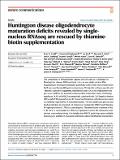Huntington disease oligodendrocyte maturation deficits revealed by single-nucleus RNAseq are rescued by thiamine-biotin supplementation
Author(s)
Lim, Ryan G; Al-Dalahmah, Osama; Wu, Jie; Gold, Maxwell P; Reidling, Jack C; Tang, Guomei; Adam, Miriam; Dansu, David K; Park, Hye-Jin; Casaccia, Patrizia; Miramontes, Ricardo; Reyes-Ortiz, Andrea M; Lau, Alice; Hickman, Richard A; Khan, Fatima; Paryani, Fahad; Tang, Alice; Ofori, Kenneth; Miyoshi, Emily; Michael, Neethu; McClure, Nicolette; Flowers, Xena E; Vonsattel, Jean Paul; Davidson, Shawn; Menon, Vilas; Swarup, Vivek; Fraenkel, Ernest; Goldman, James E; Thompson, Leslie M; ... Show more Show less
DownloadPublished version (5.063Mb)
Publisher with Creative Commons License
Publisher with Creative Commons License
Creative Commons Attribution
Terms of use
Metadata
Show full item recordAbstract
<jats:title>Abstract</jats:title><jats:p>The complexity of affected brain regions and cell types is a challenge for Huntington’s disease (HD) treatment. Here we use single nucleus RNA sequencing to investigate molecular pathology in the cortex and striatum from R6/2 mice and human HD post-mortem tissue. We identify cell type-specific and -agnostic signatures suggesting oligodendrocytes (OLs) and oligodendrocyte precursors (OPCs) are arrested in intermediate maturation states. OL-lineage regulators <jats:italic>OLIG1</jats:italic> and <jats:italic>OLIG2</jats:italic> are negatively correlated with CAG length in human OPCs, and ATACseq analysis of HD mouse NeuN-negative cells shows decreased accessibility regulated by OL maturation genes. The data implicates glucose and lipid metabolism in abnormal cell maturation and identify <jats:italic>PRKCE</jats:italic> and Thiamine Pyrophosphokinase 1 (<jats:italic>TPK1</jats:italic>) as central genes. Thiamine/biotin treatment of R6/1 HD mice to compensate for <jats:italic>TPK1</jats:italic> dysregulation restores OL maturation and rescues neuronal pathology. Our insights into HD OL pathology spans multiple brain regions and link OL maturation deficits to abnormal thiamine metabolism.</jats:p>
Date issued
2022-12-21Department
Massachusetts Institute of Technology. Department of Biological EngineeringJournal
Nature Communications
Publisher
Springer Science and Business Media LLC
Citation
Lim, Ryan G, Al-Dalahmah, Osama, Wu, Jie, Gold, Maxwell P, Reidling, Jack C et al. 2022. "Huntington disease oligodendrocyte maturation deficits revealed by single-nucleus RNAseq are rescued by thiamine-biotin supplementation." Nature Communications, 13 (1).
Version: Final published version